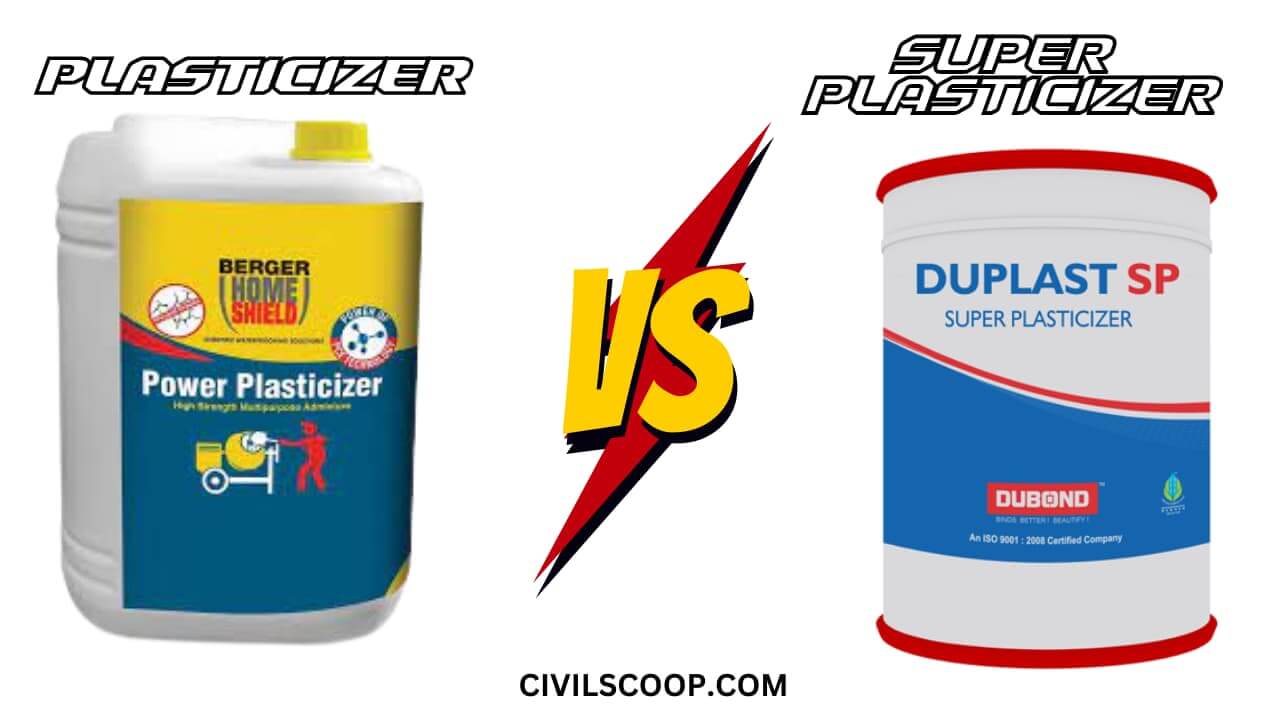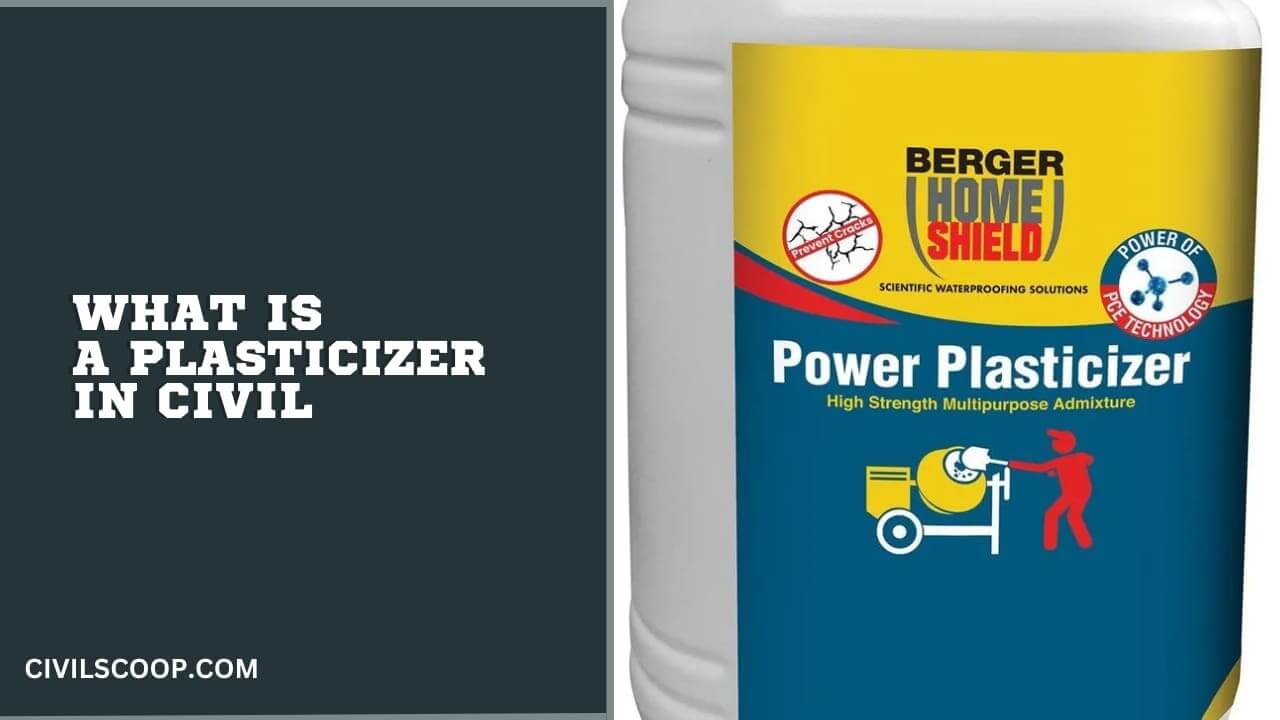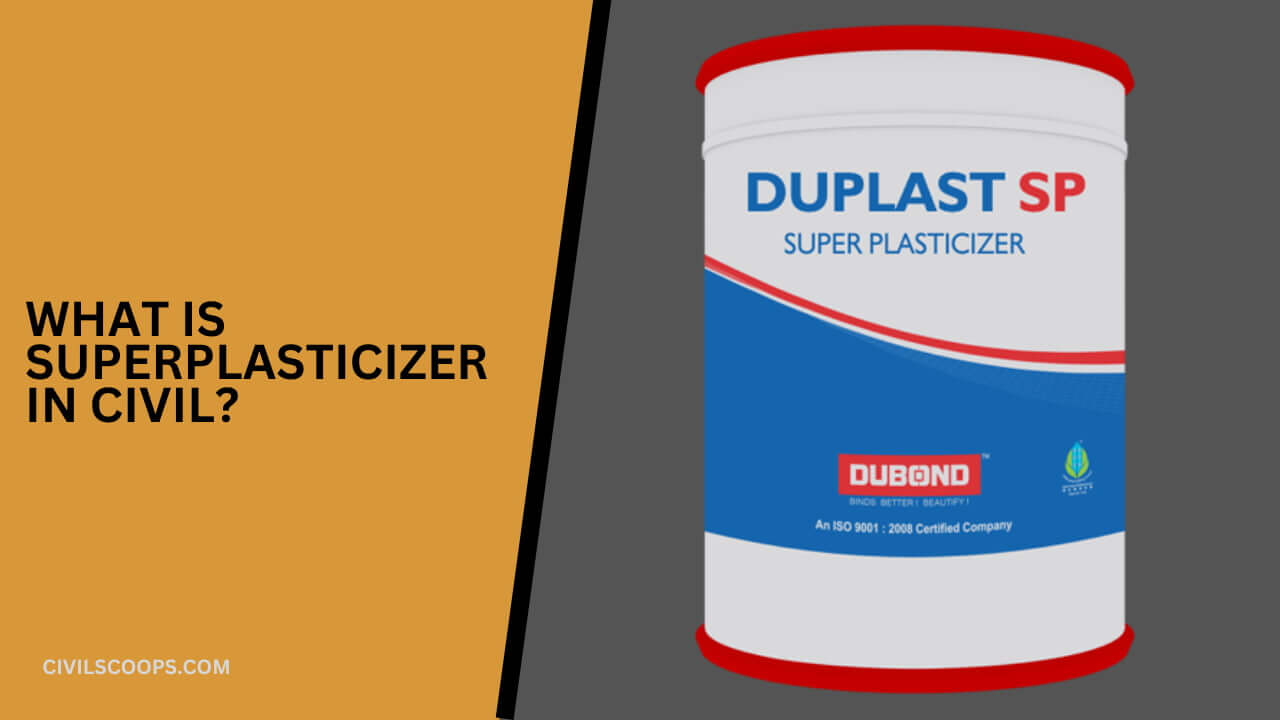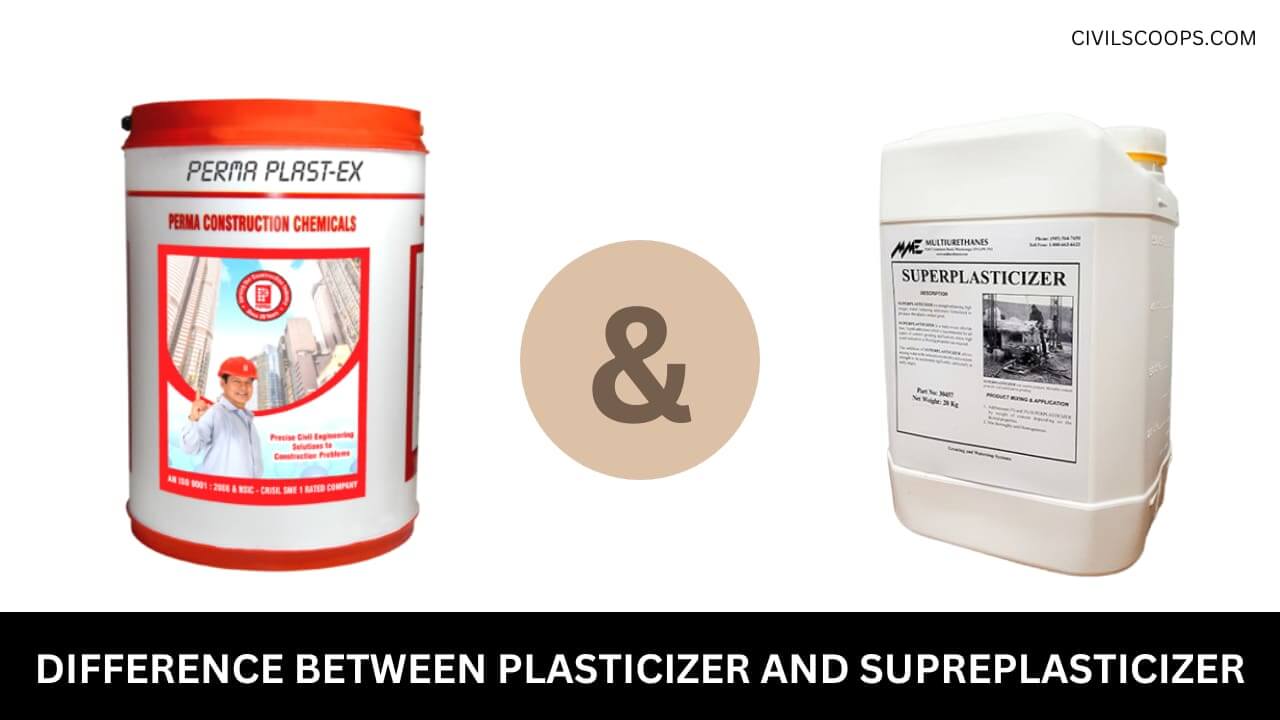Plasticizer Vs Superplasticizer | What Is Plasticizer In Civil | What Is Superplasticizer In Civil

Table of Contents
What Is Plasticizer In Civil?

Plasticizers us in concrete for the workability, Strength, and Durability of concrete. Plasticizer in concrete for Water-reducing admixtures usually reduces the required water content for a concrete mixture by about 5 to 12 percent.
The use of water-reducing admixtures is defined as Type A in ASTM C 494. The WRA mainly affects the fresh properties of concrete.
Which is measured by the dilution indicated in ASTM C 143-90. Water-reducing admixtures that delay the initial setting time by more than three hours. It is classified as a water-reducing admixture with a debugging effect (Type D).
Commonly used water-reducing admixtures (WRA) are lignosulfonates and hydrocarboxylic acids. The use of hydrocarboxylic (HC) acids as WRA requires higher water content (w/c) compared to lignosulfonates. Rapid bleeding is a problem for concrete treated with hydrocarboxylic (HC) acids.
The increase in a slump is different according to its type and dosage. The typical dosage rate is based on the cementitious material content (milliliters per hundred kilograms). The figure below illustrates the influence of the dosage of Lignosulfonates and HC acid on a slump.
It is shown in the figure that Hydro Carboxylic (HC) acids give a higher slump compared to lignosulfonates with the same dosage.
Water-Reducing Admixtures (WRA) have been used primarily in hot weather concrete pumping, placing, and tremie.
Careful concrete placement is required, as an initial setting time of cement will take place an hour earlier.
It is also shown that the use of Water-Reducing Admixtures (WRA) will give a higher initial concrete compressive strength by 10% compared to the control mixture.
Another benefit of using Water-Reducing Admixtures (WRA) is that higher concrete density is achieved, which makes the concrete less permeable and has higher durability.
Also Read: All About Mix Design of Concrete | What Is Mix Design of Concrete | Nominal Mix | Design Mix
What Is Superplasticizer In Civil?

Superplasticizers, also known as high-range water reducers, same as a plasticizer, are chemical admixtures used where well-dispersed particle suspension is required.
Polymers are used as dispersants to avoid particle segregation and also to improve the flow characteristics of suspensions such as in concrete applications.
Their addition to mortar or concrete allows a reduction of the water-to-cement ratio (W/C), not affecting the workability of the mixture, and enables the production of high-performance concrete and self-consolidating concrete.
This effect drastically improves the performance of the fresh, hardening paste. The strength of concrete increases when water to cement (W/C) ratio decreases.
Their working mechanisms lack a full understanding, revealing, in certain cases, cement-superplasticizer incompatibilities.
The addition of superplasticizers in during transit is a fairly new development within the industry.
Superplasticizer added in transit through automated slump management systems, such as Verify, allows concrete producers to maintain slump without reducing concrete quality.
Difference Between Plasticizer And Superplasticizers in Civil

[su_table responsive=”yes” alternate=”no”]
| Sr.No. | Plasticizer | Superplasticizer |
| 1 | To achieve a higher strength by decreasing the water-cement ratio at the same workability as an admixture-free mix. | Superplasticizer by Self-leveling, Self-compacting concrete, and also Penetration and compaction around dense reinforcement. |
| 2 | To achieve the same workability by decreasing the cement content so as to reduce the heat of hydration in mass concrete. | Improved durability by removing water to reduce permeability and diffusion. |
| 3 | To increase the workability so as to ease placing inaccessible locations | Reduced shrinkage, especially if combined with reduced cement content. |
| 4 | Water reduction of more than 5% but less than 12% | Water reduction of more than 6% but less than 25% |
| 5 | This Plasticizer is called a water reducer | This Superplasticizer called high range water reducer |
| 6 | It is an additive used to improve the plasticity of a certain substance | It is a water-reducing admixture capable of producing large water reduction or great flammability |
| 7 | This increases the plasticity matricidal such as water reducer in a concrete mixture | This further increases the water requirement for the concrete mixture increasing the strength and durability of concrete |
| 8 | Add plasticizer 0.1 – 0.5 % weight of cement | Add Superplasticizer 0.5 – 3% weight of cement |
[/su_table]
[su_box title=”FAQ” style=”default” box_color=”#333333″ title_color=”#FFFFFF” radius=”3″ class=”” id=””]
Difference Between Plasticizer and Superplasticizer
Plasticizers are chemical compounds that enable the production of concrete with approximately 15% less water content. Superplasticizers allow a reduction in water content by 30% or more. These additives are employed at the level of a few weight percent. Plasticizers and superplasticizers retard the curing of concrete.
What Is Superplasticizer?
Superplasticizers, also known as high-range water reducers, are additives used in making high-strength concrete. Plasticizers are chemical compounds that enable the production of concrete with approximately 15% less water content. Superplasticizers allow a reduction in water content by 30% or more.
Types of Superplasticizer
Generally, superplasticizers can be classified into such types: purified lignosulfonates, carboxylate synthetic polymers, sulfonated synthetic polymers, and synthetic polymers with mixed functionality cementitious materials.
What Are Superplasticizers in Concrete?
Superplasticizers (SPs), also known as high-range water reducers, are additives used in making high-strength concrete. Plasticizers are chemical compounds that enable the production of concrete with approximately 15% less water content. Superplasticizers allow a reduction in water content by 30% or more.
Use of Superplasticizer in Concrete
Superplasticizers are commonly used in dry-pressed concrete to improve workability and to enhance the compaction of concrete for increasing density and improving the surface finish of the concrete product.
What Is Plasticizer?
A plasticizer is a substance that is added to a material to make it softer and more flexible, to increase its plasticity, to decrease its viscosity, and/or to decrease friction during its handling in manufacture.
What Are Plasticizers in Concrete?
Plasticizers are chemical compounds that enable the production of concrete with approximately 15% less water content. Superplasticizers allow a reduction in water content by 30% or more. These additives are employed at the level of a few weight percent.
Types of Plasticizers
The most common plasticizers include esters such as adipates, azelates, citrates, benzoates, ortho-phthalates, terephthalates, sebacates, and trimellitates.
Use of Plasticizer in Concrete
The plasticizer is used to increase workability in concrete. Due to plasticizers, we can reduce the water-cement ratio up to a certain limit. Basically, the water-cement ratio is used for the workability and hydration of cement.
Plasticizer and Superplasticizer
Plasticizers are chemical compounds that enable the production of concrete with approximately 15% less water content. Superplasticizers allow a reduction in water content by 30% or more. These additives are employed at the level of a few weight percent. Plasticizers and superplasticizers retard the curing of concrete.
How many plasticizers to Use in Concrete?
Superplasticizer dosage is 0.5- 1 % by weight of cementitious material.” “For 90 lbs(40 kg) (bag of cement) you’ll need approximately 1 lb(0.45 kg) of GlobMarbe superplasticizer.” * Less water is required, resulting in stronger final concrete.
How Much Superplasticizer to Add to Concrete?
Superplasticizer dosage is 0.5- 1 % by weight of cementitious material. For 100 lbs(45.3 kg) (bag of cement) you’ll need approximately 1 lb(0.45 kg) of GlobMarbe superplasticizer. We recommend starting with 1% by cement weight, then lowering the dosage as needed.
Examples of Plasticizer
The most common plasticizers include esters such as adipates, azelates, citrates, benzoates, ortho-phthalates, terephthalates, sebacates, and trimellitates.
Example of Superplasticizer
Well-known examples of admixtures are superplasticizers. Superplasticizers are usually chemical compounds such as sulfonated melamine formaldehyde (SMF), sulfonated naphthalene formaldehyde (SNF), modified lignosulphonates (MLS), and polycarboxylate derivatives [1], [2].
Superplasticizer Cement Ratio
The percentages of superplasticizers by weight of cement are limited to 1%, 1.25%, and 1.5% by individual batches of concrete production. The aggregates and cement were subjected to laboratory experiments before the production of fresh concrete.
Name of Plasticizer Used in Concrete
Superplasticizers (SPs), also known as high-range water reducers, are additives used in making high-strength concrete.
Plasticiser in Concrete Mix
Plasticizers are chemical compounds that enable the production of concrete with approximately 15% less water content.
Superplasticizer in Cement Concrete
Superplasticizers (SPs), also known as high-range water reducers, are additives used in making high-strength concrete. Plasticizers are chemical compounds that enable the production of concrete with approximately 15% less water content. Superplasticizers allow a reduction in water content by 30% or more.
Plasticizer Admixture
Plasticizers are the admixtures used to mix in cement to improve their qualities and make them suitable for construction. Its effects on concrete: 1)Reduce the water/cement ratio without any effect on workability. 2)It increases setting time. It allows transit mixers to transport concrete to long distances.
Mechanism of Plasticizer
The function of plasticizers is to reduce the intensity of bonds among the polymer molecules. These bonds, or attractions between molecules (Van de Waals forces), give a large rigidity to PVC.
What Does Superplasticizer Do to Concrete?
Superplasticizers (SPs), also known as high-range water reducers, are additives used in making high-strength concrete. Plasticizers are chemical compounds that enable the production of concrete with approximately 15% less water content. Superplasticizers allow a reduction in water content by 30% or more.
What Is Plasticizers in Concrete?
Plasticizers are chemical compounds that enable the production of concrete with approximately 15% less water content. Superplasticizers allow a reduction in water content by 30% or more. These additives are employed at the level of a few weight percent.
What Is the Advantage of the Use of Superplasticizer?
Superplasticizers Help Keep Concrete Strong
Composed of more advanced, higher-value chemicals than standard and mid-range water reducers, superplasticizers decrease the water-cement ratio while providing such benefits as increased density. improved bond strength. greater volume stability and reduced shrinkage cracking.
What Are Plasticizers Used For?
Plasticizers are added to plastics to make them flexible, pliable, and processable. There are two types of plasticizers: (1) the primary plasticizer and (2) the secondary plasticizer or extender. The primary plasticizer improves the elongation and softness of the plastic.
What Is a Plasticizer and How Does It Work?
Starting with the basics, a plasticizer is a low-volatility liquid or solid substance that’s added to a raw polymer like a type of plastic or rubber to improve its flexibility, make it easier to shape and mold, and reduce friction on its surface.
How Does Superplasticizer Work in Concrete?
Plasticizers are chemical compounds that enable the production of concrete with approximately 15% less water content. Superplasticizers allow a reduction in water content by 30% or more. These additives are employed at the level of a few weight percent. Plasticizers and superplasticizers retard the curing of concrete.
What Does a Plasticizer Do?
Plasticizers are added to plastics to make them flexible, pliable, and processable. There are two types of plasticizers: (1) the primary plasticizer and (2) the secondary plasticizer or extender. The primary plasticizer improves the elongation and softness of the plastic.
What Does Mortar Plasticiser Do?
It helps reduce grittiness to provide a smooth easy-to-work mortar with improved durability and protection against frost. It also reduces the water content of the mortar. Bostik Mortar Plasticiser is suitable for use to improve mortars for applications such as; bricklaying, blockwork, and rendering.
What Does Cement Plasticiser Do?
Plasticizers (admixtures or dispersants) are substances added to materials such as cement mortar mixes (as well as to plaster and concrete) to decrease viscosity and plasticity and increase workability and performance.
What Are the 3 Types of Plasticizers?
Plasticizers are added to plastics to make them flexible, pliable, and processable. There are two types of plasticizers: (1) the primary plasticizer and (2) the secondary plasticizer or extender. The primary plasticizer improves the elongation and softness of the plastic.
[/su_box]
[su_note note_color=”#F2F2F2 ” text_color=”#333333″ radius=”3″ class=”” id=””]
Like this post? Share it with your friends!
Suggested Read –
- All About Sand | What Is Sand | 29 Types of Sand | Composition of Sand
- 19 Different Types of Slabs in Construction | What Is a Slab | Types of Slabs
- All About Gypsum Plaster | What Is Gypsum Plaster | 15 Advantage of Gypsum Plaster | Disadvantage of Gypsum Plaster
- All About M Sand | What Is M Sand | Properties of Manufactured Sand | Advantages & Disadvantages of Manufactured Sand
- All About Uscs | Which Test Gives a Better Estimation of the Friction Angle | Introduction of USCS ( Unified Soil Classification System )
[/su_note]
Originally posted 2023-02-20 13:09:38.
